An ambivalence to life reflected nowhere more so than the child’s relationship to memory, at once complete, graphic and epic yet vague, blurry and unfinished. And why not, given the facility to escape, to flee at one’s leisure the fairytale forest, not always enchanted, of weird forms, seemingly bizarre and the mysterious enigmatic symbols by simply turning them out, discarding them in favor of facing the facts of social life which have a much more interesting and primeval inevitability; for this world of reason has no charisma and neither do its classical forms.
Yes, even then, reason, common sense and the classical invoked the sense of time; an awareness of time and with it an awareness of death. Perhaps Kandinsky was right in saying the child is the greatest imaginer since reason and self control hold so little currency and one can live in the impulsive present and watch the dissolving of clouds and be close to the permeable place in the life of things. Yes, the child has access to imagination, in its blurriness and constantly flowing transitions creating a wall of abstractions as to be virtually incomprehensible to an outsider where color is synthesized as grammar and finding subjective means to express a universal form of communication seems to be essence in itself and not a paradoxical romantic enterprise…
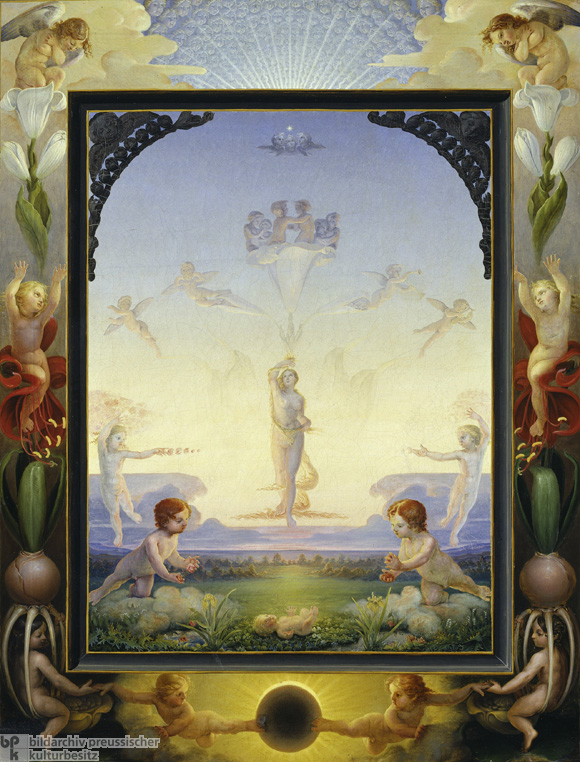
Runge. ---is perhaps the oddest and, at the same time, the most representative image of early Romanticism. Many early-nineteenth-century painters and writers had an intense interest in idealist and transcendental theories. From the writings of Johann Ludwig Tieck (1773-1853) and Novalis (1772-1801) to the paintings of Caspar David Friedrich, German Romantic art tried to put into practice the mystical belief that the natural, visible world contained hidden, spiritual meanings that could be unlocked in the higher consciousness of an artist and conveyed to an audience by means of a symbolic language. Like Friedrich, a fellow Pomeranian, Runge grew up in the northern Protestant tradition of pietist nature worship. In painting, this tradition could be traced at least as far back as Albrecht Dürer (1471-1528) and combined a rigorous study of nature with an intensely religious reverence for the beauty of landscape. The early Romantics, however, took this combination of naturalism and symbolism to an almost hieroglyphic extreme. In Small Morning, for instance, natural phenomena such as color and light are supposed to express the earthbound soul’s progress toward liberation.--- Read More:http://germanhistorydocs.ghi-dc.org/sub_image.cfm?image_id=2207
…The experience of imagination is one of a blurring of things, a meditative world “without compulsion” or the sharp, clear outlines of an empirical acuity, and world where “death” and “doom” become “an unending series of transitions.” The world of imaginative experience, in the state of mind Benjamin means by “imagination,” has the fullness and bleed of watercolor, or a child’s restless story, “permeated by a rich flow of events,” but in a state of dissolution that results in “eternal ephemerality”: everything in that domain flows, and all is suddenly gone, washed out in the Chock of the tram rattling to a halt and the conductor’s shout….
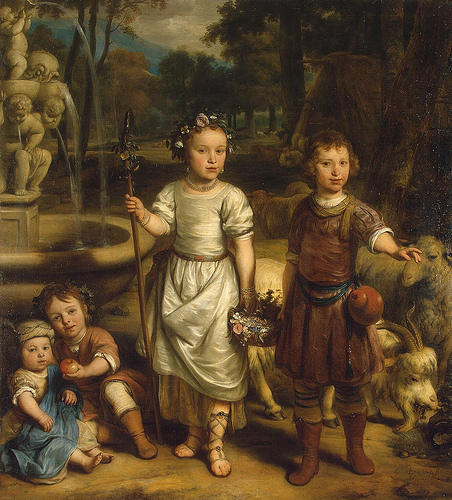
---This is why Benjamin describes the child as “picturing”: in color is located “the inward nature of this way of seeing.” But what does this mean? In means that color, like riddle, imagination, the expressionless, and to a fascinating degree writing itself, is at the border where a seeing can catch sight of itself, where there is an exchange with the intentionless, the expressionless. --- Read More:http://finnb.net/a/b/writing.html image:http://gandalfsgallery.blogspot.com/2011_08_01_archive.html
… “It is,” he writes, “like the sun setting over the abandoned theater of the world with its deciphered ruins.” Imagination does not have the tension at its heart, the moment of self-reflexivity on the part of the work, in which the expressionless can occur, and it lacks the meticulousness in which the thing can, in some sense, come to voice in the intensive observer. The ruins have been deciphered, the hidden word of the riddle revealed, the theater abandoned: there is no compulsion, no tragic doom, just the soft blurring together of things and the sense of a world without end. The sun is setting: for Benjamin, the place where imagination comes into its own as an experience is “at dawn and at dusk,” both cosmically and in an individual life, in Paradise and childhood, and in the “reduced, extinguished, or muted” — but not deathly, grieving, mournful — state of the abandoned theater, the twilight….
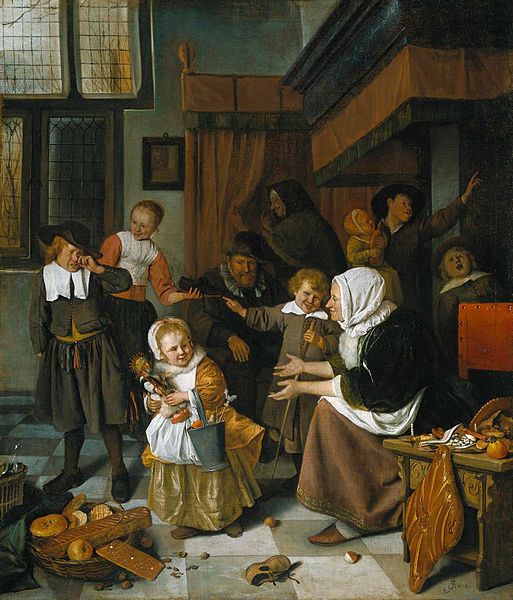
jan steen.---The child learning to write, whose hand set out on “a long journey with pauses for it to spend the night,” is writing by just this moonlight, in a world of doppelgängers, where what once had been continues in the writing, where the hat is also the “hat,” or “Hut,” or yet not; an alternate earth, the “home” of creation, which begins to suggest the space of mimesis where memories have a presence of their own and the theater of the day is revealed to be run by subtle and atavistic powers.---- Read More:http://finnb.net/a/b/writing.html image:http://chasblogspot.blogspot.com/2011/12/merry-christmas-courtesy-of-jan-steen.html
…The blurriness of imagination is the “radiance that surrounds the objects in Paradise.” (Here he footnotes the painter Philipp Otto Runge, a Romantic whose paintings, such as Der Morgen, deploy highly theatrical lighting effects, particularly a love of 25,000 kilowatts of hot yellow sunrise. Before his death, Runge produced Die Farbenkugel, an extraordinary document developed after consultations with Goethe in which all the colors are displayed on a sphere in axes of saturation, brightness, and hue; everything fades into everything else, a primeval world of color.) So the beginning; at the end, it is “the gray Elysium,” a suspended world of “pure appearance,” which comes with twilight, dusk, and clouds and mist: “De-formation occurs also in the acoustic realm (so that, for example, the night can reduce noises to a single great humming), or the tactile (as when the clouds dissolve in the blue or the rain).”
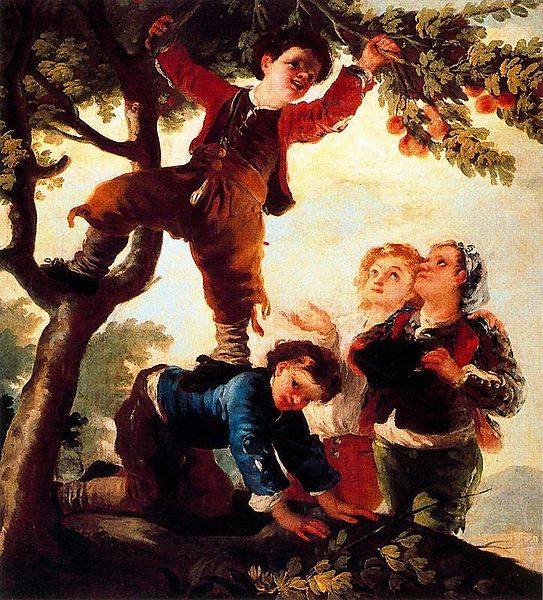
---“For children are particularly fond of haunting any site where things are being visibly worked. They are irresistibly drawn by the detritus generated by building, gardening, housework, tailoring, or carpentry. In waste products they recognize the face that the world of things turns directly and solely to them. In using these things, they do not so much imitate the works of adults as bring together, in the artifact produced in play, materials of widely differing kinds in a new, intuitive relationship. Children thus produce their own small world of things within the greater one.”--- Read More:http://finnb.net/a/b/writing.html image:http://www.goyaexperts.com/plogger/index.php?level=picture&id=118
…Though imagination cannot produce of itself a “pure work of art,” it — “pure conceiving” — is “the basis of every work of art.” “Every work of art is grounded in the imagination,” but the pure work, that which steps beyond the riddle to actually host within itself the expressionless to which the riddle only alludes, takes some formed thing into its production, with an awareness of “the process of de-forming itself”; that thing must “become of fundamental importance for the work.” Within that thing in the work is the meticulousness that can take account of even the blurring, de-forming imagination that first invited the thing into the brushstrokes, the words, the movements….
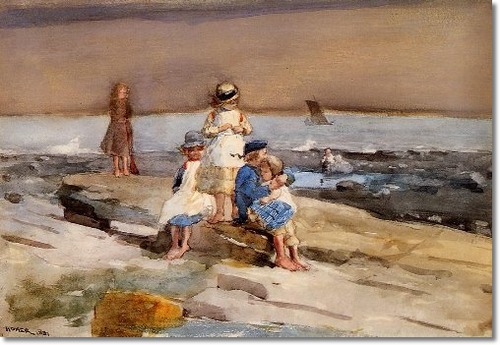
Winslow Homer. ---In a marvelous turn that seems constitutive of so much of his style of writing and thinking, he continues: “The fairy tale is such a waste product — perhaps the most powerful to be found in the spiritual lif
humanity: a waste product that emerges from the growth and decay of the saga. Children are able to manipulate fairy stories with the same ease and lack of inhibition that they display in playing with pieces of cloth and building blocks.” --- Read More:http://finnb.net/a/b/writing.html image:http://www.encore-editions.com/winslow-homer-children-on-the-beach
…Not all artists can do this: Benjamin mentions Jean Paul as one with “the greatest imagination” who could not “keep the de-forming powers under control.” (Bloch was the first of many to see Benjamin as one of a small group of writers, Jean Paul pre-eminent among them, who engaged in “incidental thinking.”) In this regard — and this is a critical jump — Paul, so fully possessed of the imagination, “came closest to the minds of children.” Children are the dawn in which the imagination exists in one of its pure states, an idea that Benjamin turns over in a slightly different form in his thoughts on the colors of children’s books, and their peculiar, blurry vividness. The child and child’s experience is the last of Benjamin’s critical areas of alternate epistemology (he himself had an exceptionally acute memory of his childhood), and provide another realm for looking at the thing — and a jumping-off point for the refinement of the idea of the expressionless in the work of art into the idea of the nonsensuous similarity in the act of writing.Read More:http://finnb.net/a/b/writing.htmla




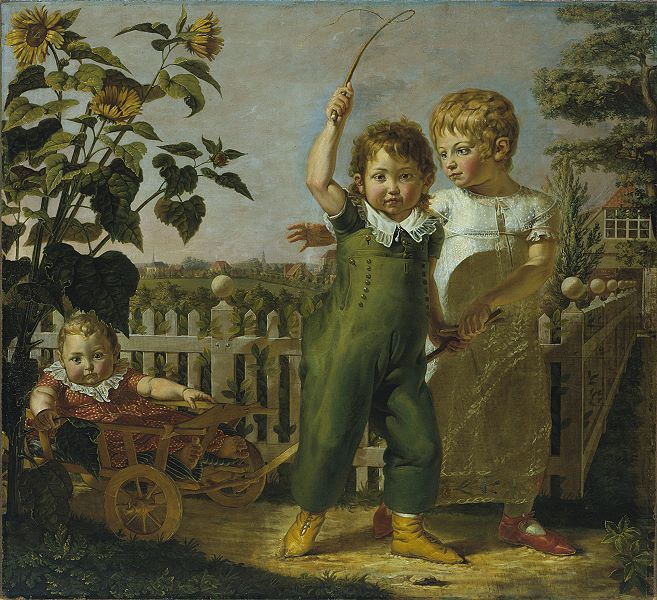




 COMMENTS
COMMENTS



